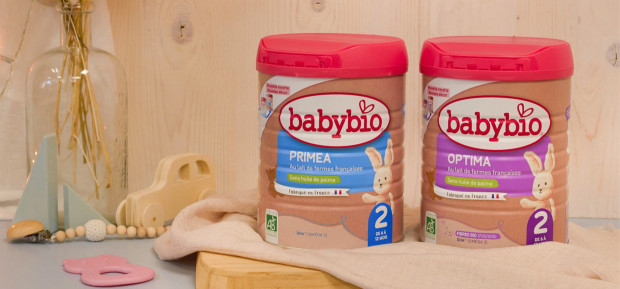Growth Infant Milk, an ally for children over 10 months old
Baby just turned 10 months old? Are you wondering if it is now necessary to supplement your diet with "Growth" Milk? Babybio takes stock and explains everything you need to know about 3rd age milk.
What is Growth Infant Milk?
Infant Milk Growth is a milk formula based on cow's or goat's milk intended for children of 10 months, 1, 2, and 3 years old. Enriched with iron, essential fatty acids and zinc, Growth Infant Milk meets the nutritional needs of young children in accordance with regulations; it provides them with all the necessary contributions for their development in addition to a fully diversified diet.
What is the composition of Infant Growth Milk?
Infant Milk "Growth" is a formula based on milk of animal origin whose composition has been modified to precisely meet the nutritional needs of the child. It contains :
• Between 20 to 30 times more iron than cow's milk (depending on the preparation)
• Twice as much zinc as cow's milk
• An amount of calcium equivalent to that of cow's milk
Growth Infant Milk is also an excellent source of essential fatty acids, especially Omega 6 and Omega 3, very little present in animal milk. Its formula has also been supplemented with vitamins A, D, E, C.
Growth Infant Milk also has a protein content that is half that of cow's milk (which can cause excessive protein consumption in children). The salt content of Growth Infant Milk is also lower than that of animal milk.
What are the differences between 2nd age infant milk and Growth milk?
Like 2nd age milk (or follow-on milk), Growth Infant Milk has the nutritional benefits necessary to be able to be used in addition to and / or as a substitute for breastfeeding; our growth formulas are recommended from 10 months, unlike follow-on milk, which can be offered to babies from 6 months, and whose composition is governed by the regulations applicable to infant milks.
Infant milk intended for young children (regulatory name for Infant Growth Milk) also complies with the same manufacturing criteria as 2nd age infant milk. Infant milk Growth therefore shows few differences from 2nd age milk in terms of preparation: only the content of certain components differs between the two products to allow 3rd age milk to meet the nutritional needs of the child.
Which infant milk to choose for the growth of your child?
Infant milk Growth or whole cow's milk?
It is common for parents to wonder about the use of cow's milk from their little one 10 months old. However, at this age, unlike Growth Infant Milk, cow's milk, even whole, is not able to meet all the nutritional needs of the child:
• Iron, more present in growing milk, contributes to the cognitive development of young children.
• Zinc, twice as present in growth milk as cow's milk, contributes to the normal functioning of the immune system.
• Growth Infant Milk is less rich in protein than cow's milk.
Note: the Nutrition Committee of the French Pediatric Society and the PNNS (National Health Nutrition Program) specified in their 2011 report that “growth milks are foods that help correct the inadequate intakes frequently observed in children. 1-3 years when used in place of cow's milk ”.
Infant milk Growth powder liquid: which one to choose?
Growth infant milk is marketed in powder or liquid form (ready to use). These two ranges are framed by the same regulations. Your choice must therefore depend above all on your storage and use preferences:
• 3rd age powdered milk is easier to store when traveling;
• bottled infant milk is easier to use; once opened, it can only be kept for a maximum of 48 hours in the refrigerator, compared to 4 weeks for the powder format.
The benefits of Organic Growth Infant Milk
Organic Growth infant milks have the advantage of meeting a double requirement:
• Their nutritional formula applicable to follow-on milk allows them to ideally complement the diversified diet of children from 10 months to 3 years old
• The milk used to develop Organic Growth infant milks comes from animals raised in France, fed with grass and / or organic fodder according to the strict regulations governing organic farming (preventive treatment of animals with antibiotics is by elsewhere prohibited)
In addition to guaranteeing your child healthy products of perfectly traceable quality, choosing organic infant milk contributes to respect for sustainable development and the preservation of the environment. Convictions that are dear to us at Babybio.
Can plant-based drinks replace Growth infant milk?
Vegetable drinks, improperly called "vegetable milk", are now appreciated by many French people. However, they are unsuitable for feeding young children: poor in calcium and essential fatty acids, they also have a low intake of protein, lipids and iron. These vegetable drinks, which have nothing in common with milk, are therefore unable to meet the nutritional needs of children.
How to prepare Growth Infant Milk?
Is your box of Growth infant milk ordered? Here are our tips for preparation.
How much infant milk for your child?
Pediatricians recommend the consumption of a minimum of 500 ml of infant milk per day for a child between the age of 10 months and 3 years. This amount corresponds to two bottles of Growth Infant Milk, to give your baby for breakfast and afternoon tea, for example, or for breakfast and bedtime.
It is of course possible to offer Infant Milk Growth to your little one in a glass, a bowl or a dessert (as a smoothie, in particular). For example, you can prepare a bowl of cereal for breakfast with 250 ml of Infant Growth Milk, and complete its taste with a glass of infant milk (25 cl), a piece of fruit and a cereal product.
How to warm up the Growth Infant Milk?
Baby Growth Milk can be consumed warm or at room temperature depending on your child's preference. If your little one wants to drink his bottle a little warm, warm the water in the saucepan (which will be used for the preparation) or the infant milk (if it is liquid 3rd age milk). You can also pour your cold preparation into the bottle and use a bottle warmer, or heat it in a water bath.
However, avoid using the microwave oven: this solution does not allow you to heat the infant milk evenly and may cause the risk of burns. You can also check the temperature of the liquid by placing a few drops on the inside of your wrist.
Can we change Infant Milk Growth?
As with any milk drink, your child may have difficulty tolerating a Specific Growth Infant Milk. Whatever the reason, the change should be made gradually and always with the advice of the doctor who follows the baby. For a smooth transition, start by alternating between the Growth Infant Milk previously used and the new range. Babybio offers children who do not appreciate cow's milk-based formulas a growth milk with goat's milk.
When to stop Growth Infant Milk?
Growth Infant Milk is generally offered to children up to the age of 3. From this age, you can start to introduce cow's milk into your toddler's diet, favoring whole milk over semi-skimmed milk, which has better calcium and fat intake. The transition should be done smoothly over several days. If your little boy or girl loves 3rd age milk, it is quite possible to offer it to him after he is 3 years old.
Frequently Asked Questions
1 - At what age to start Growth Infant Milk?
Infant Growth Milk can be offered to a child from 10 to 12 months old when his diet is completely diversified. It can then be consumed by children up to the age of 3 and beyond if desired.
2 - When to give Growth Infant Milk?
Consumption of Growth Infant Milk can be spread throughout the day, depending on the child's preferences - for breakfast and afternoon tea, for example, or for breakfast and bedtime depending on cases. The important thing is to offer him a minimum of 500 ml of Growth Milk over the day.
3 - What is the best growth infant milk?
The composition of the Growth infant formula available on the market can vary significantly from one brand to another. To offer your child quality infant milk from French animals fed with good products, it is advisable to use Organic Growth Infant Milk.
4 - What infant milk for a 2 year old child?
A 2-year-old is still too small to drink mostly cow's milk. At this age, Growth Infant Milk is recommended to cover all of her nutritional needs, and in particular to provide her with a sufficient supply of iron, essential fatty acids and zinc.
5 - What infant milk for a 10 month old child?
A baby can start drinking Growth Infant Milk as early as 10 months when the product meets the regulations applicable to follow-on milk. At that age, he can also still consume 2nd age milk (up to 12 months) because its composition meets his needs.


